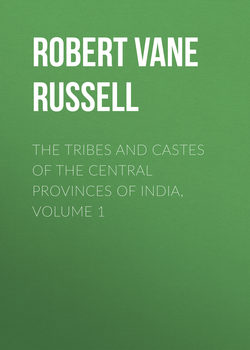Читать книгу The Tribes and Castes of the Central Provinces of India, Volume 1 - Robert Vane Russell - Страница 37
Part I.
Introductory Essay on Caste
Introductory Essay on Caste
34. The non-Aryan tribes
ОглавлениеThe fourth group in the scheme of precedence comprises the non-Aryan or indigenous tribes, who are really outside the caste system when this is considered as the social organisation of the Hindus, so long at least as they continue to worship their own tribal deities, and show no respect for Brāhmans nor for the cow. These tribes have, however, entered the Hindu polity in various positions. The leaders of some of them who were dominant in the early period were admitted to the Kshatriya or Rājpūt caste, and the origin of a few of the Rājput clans can be traced to the old Bhar and other tribes. Again, the aristocratic or landholding sections of several existing tribes are at present, as has been seen, permitted to rank with the good Hindu cultivating castes. In a few cases, as the Andhs, Halbas and Mānas, the tribe as a whole has become a Hindu caste, when it retained possession of the land in the centre of a Hindu population. These have now the same or a slightly higher position than the village menial castes. On the other hand, those tribes which were subjugated and permitted to live with a servile status in the Hindu villages have developed into the existing impure castes of labourers, weavers, tanners and others, who form the lowest social group. The tribes which still retain their distinctive existence were not enslaved in this manner, but lived apart in their own villages in the forest tracts and kept possession of the land. This seems to be the reason why they rank somewhat higher than the impure castes, even though they may utterly defile themselves according to Hindu ideas by eating cow’s flesh. Some tribes, such as the Gonds, Binjhwārs and Kawars, counted amongst them the owners of large estates or even kingdoms, and consequently had many Hindu cultivators for their subjects. And, as the Hindus themselves say, they could not regard the Gonds as impure when they had a Gond king. Nevertheless, the Gond labourers in Hindu villages in the plains are more despised than the Gonds who live in their own villages in the hill country. And the conversion of the tribes as a whole to Hinduism goes steadily forward. At each census the question arises which of them should be classed as Hindus, and which as Animists or worshippers of their own tribal gods, and though the classification is necessarily very arbitrary, the process can be clearly observed. Thus the Andhs, Kolis, Rautias and Halbas are now all Hindus, and the same remark applies to the Kols, Bhīls and Korkus in several Districts. By strict abstention from beef, the adoption of Hindu rites, and to some extent of child-marriage, they get admission to the third group of castes from whom a Brāhman cannot take water. It will be desirable here to digress from the main argument by noticing briefly the origin and affinities of the principal forest tribes of the Central Provinces.
